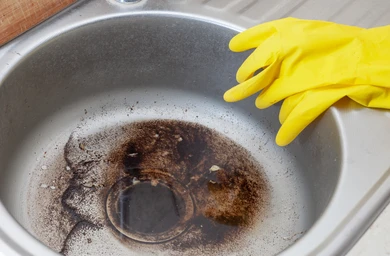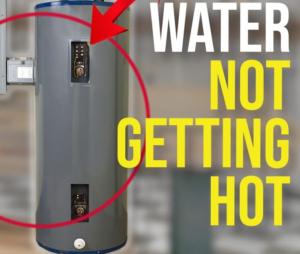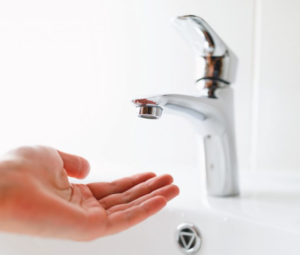A clogged sink is one of the most frustrating household issues. Water pooling in the basin, slow drainage, and unpleasant odors can be signs that something is wrong with your plumbing. Whether it’s your kitchen sink or bathroom vanity, knowing why your sink won’t drain and how to fix it can save you time, money, and prevent further damage. This guide will walk you through common causes of a clogged sink and provide practical solutions for how to clear the blockage and prevent future issues.
Common Reasons Why Your Sink Won’t Drain
Before you jump into fixing the problem, it’s important to understand what might be causing the issue. Here are some of the most common reasons why sinks clog and stop draining properly:
1. Hair Accumulation
In bathroom sinks, hair is often the main culprit behind a clog. Hair can easily get caught in the drain, where it tangles and mixes with soap scum and other debris, forming a stubborn blockage. Over time, this mass can become large enough to slow or completely stop water from draining.
2. Food Particles
In kitchen sinks, food scraps are a major cause of clogs, especially if there is no garbage disposal installed. Grease, fat, coffee grounds, and food remnants can build up in the pipes, creating a blockage that restricts the flow of water.
3. Grease and Fat
Another leading cause of kitchen sink clogs is the accumulation of grease and fat. When poured down the drain, grease can solidify and stick to the walls of the pipes. As more grease and food particles pass through, they adhere to the buildup, eventually blocking the drain.
4. Soap Scum
Over time, soap can accumulate inside pipes, particularly in bathroom sinks. When combined with hard water minerals, soap can form a residue that narrows the pipes and causes drainage problems. This buildup is particularly common in areas with hard water.
5. Foreign Objects
Small items such as jewelry, toothbrushes, or even children’s toys can accidentally fall into the drain and cause blockages. These foreign objects can get lodged in the pipes, obstructing water flow and requiring more invasive methods of removal.
6. Mineral Buildup
In areas with hard water, minerals can build up inside the pipes, reducing their diameter over time. This leads to slower drainage and, in severe cases, complete blockages. This type of clog typically happens over a longer period and might require professional assistance to resolve.
How to Fix a Sink That Won’t Drain
Once you’ve identified the potential cause of the clog, there are several ways to fix the issue. Some methods are simple and can be done with household tools, while others may require a bit more effort. Here are six effective ways to unclog your sink:
1. Boiling Water
The simplest solution is often the most effective, especially if the clog is caused by grease or soap scum. Boil a kettle of water and carefully pour it down the drain in two to three stages, allowing the water to work its way through the clog. This method works best for minor blockages and should be used cautiously if your pipes are made of plastic, as extremely hot water can soften them.
2. Plunger
A plunger can be highly effective for dislodging clogs in both kitchen and bathroom sinks. Start by filling the sink with enough water to cover the plunger’s cup. Place the plunger over the drain and press down firmly to create suction. Pump the plunger up and down several times, then quickly lift it off the drain. If the water begins to drain, you’ve successfully loosened the clog. If not, repeat the process a few more times.
3. Baking Soda and Vinegar
A natural and eco-friendly solution to clearing sink clogs is a combination of baking soda and vinegar. First, pour a cup of baking soda down the drain, followed by a cup of white vinegar. The mixture will fizz and bubble as it reacts, helping to break down the clog. After about 15 minutes, flush the drain with boiling water to wash away the debris. This method works well for minor clogs caused by grease, soap scum, or food particles.
4. Drain Snake
For more stubborn clogs, a drain snake or plumber’s auger may be necessary. Insert the snake into the drain and push it through the pipe until you feel resistance. Turn the handle to break up or hook onto the clog, then pull it out of the drain. This tool is particularly useful for removing hair and foreign objects lodged deep in the pipes.
5. Remove and Clean the P-Trap
The P-trap is the curved section of pipe located under your sink. It’s designed to trap debris and prevent it from entering the rest of your plumbing system. If other methods haven’t worked, you may need to remove the P-trap and clean it out manually. Place a bucket underneath the P-trap to catch any water or debris, then use a wrench to loosen the slip nuts and remove the pipe. Clean out any buildup inside the P-trap, then reassemble the pipes and run water to see if the clog is cleared.
6. Call a Professional
If none of these methods work, or if you suspect the clog is deep within your plumbing system, it may be time to call a professional plumber. A licensed plumber has the tools and expertise to tackle even the most stubborn clogs, and they can help you avoid potential damage to your pipes from improper DIY attempts.
Preventing Future Clogs
Once you’ve successfully unclogged your sink, take steps to prevent future clogs from occurring. Regular maintenance and mindful usage can go a long way in keeping your sink draining smoothly.
1. Use a Drain Strainer
A drain strainer is an inexpensive and effective way to prevent food particles, hair, and other debris from entering your pipes. Place a strainer over your kitchen and bathroom drains and clean it regularly to ensure water can flow freely.
2. Avoid Pouring Grease Down the Drain
Never pour grease, fat, or oil down the drain. Instead, allow it to cool and solidify, then scrape it into the trash. This will prevent grease from building up in your pipes and causing clogs.
3. Flush with Hot Water Regularly
Periodically flushing your sink with hot water can help dissolve grease and soap scum before they harden and cause a clog. Doing this once a week can significantly reduce the likelihood of blockages.
4. Be Mindful of What Goes Down the Drain
In the kitchen, scrape food scraps into the trash or compost bin instead of rinsing them down the sink. In the bathroom, avoid washing hair and other small items down the drain.
Final Thoughts
A clogged sink can be a major inconvenience, but with the right approach, most blockages can be resolved quickly and easily. By understanding the common causes of sink clogs and using the appropriate methods to clear them, you can save yourself from costly plumbing repairs down the road. And by adopting good habits to prevent clogs, you can keep your sink draining smoothly for years to come.
FAQ
- Why is my sink not draining properly?
- A sink that won’t drain could be caused by a clog in the pipes, buildup of debris such as food, grease, or soap, or a blockage in the P-trap. It can also be due to issues with the garbage disposal or the sink vent.
- What are the common causes of sink clogs?
- Common causes include food scraps, grease buildup, hair, soap scum, and small objects that accidentally go down the drain. Mineral deposits from hard water can also contribute to clogs over time.
- How can I fix a clogged kitchen sink myself?
- You can try using a plunger, pouring a mixture of baking soda and vinegar followed by hot water, or using a plumber’s snake to break up the blockage. In some cases, removing and cleaning the P-trap can help.
- Is it safe to use chemical drain cleaners?
- While chemical drain cleaners can be effective, they can also damage pipes, especially if used frequently. It’s best to use them sparingly or opt for natural remedies like baking soda and vinegar.
- What should I do if my sink is still not draining after trying DIY fixes?
- If DIY methods don’t work, there may be a more serious blockage deeper in your plumbing system. In such cases, it’s best to contact a professional plumber for a thorough inspection and fix.
- How can I prevent my sink from clogging in the future?
- To prevent clogs, avoid putting food scraps, grease, or coffee grounds down the drain. Use a sink strainer to catch debris, run hot water through the pipes regularly, and clean the P-trap periodically.
- What’s the difference between a slow-draining and completely clogged sink?
- A slow-draining sink usually indicates a partial blockage, which can often be cleared with simple remedies. A completely clogged sink means no water can pass through, requiring more extensive methods like snaking or professional help.
- Could the problem be related to the garbage disposal?
- Yes, if your sink is connected to a garbage disposal, a jammed or malfunctioning disposal unit could prevent the sink from draining. Try resetting the disposal or using a wrench to unjam it.
- When should I call a plumber for a clogged sink?
- You should call a plumber if home remedies don’t resolve the issue, if multiple drains are clogged, or if you notice recurring blockages. Professional intervention is also needed if there’s a foul odor or signs of a more severe plumbing problem.
- Can clogged sinks cause other plumbing problems?
- Yes, a clogged sink can lead to pipe leaks, unpleasant odors, and even backups in other parts of the home’s plumbing system if not addressed promptly.





